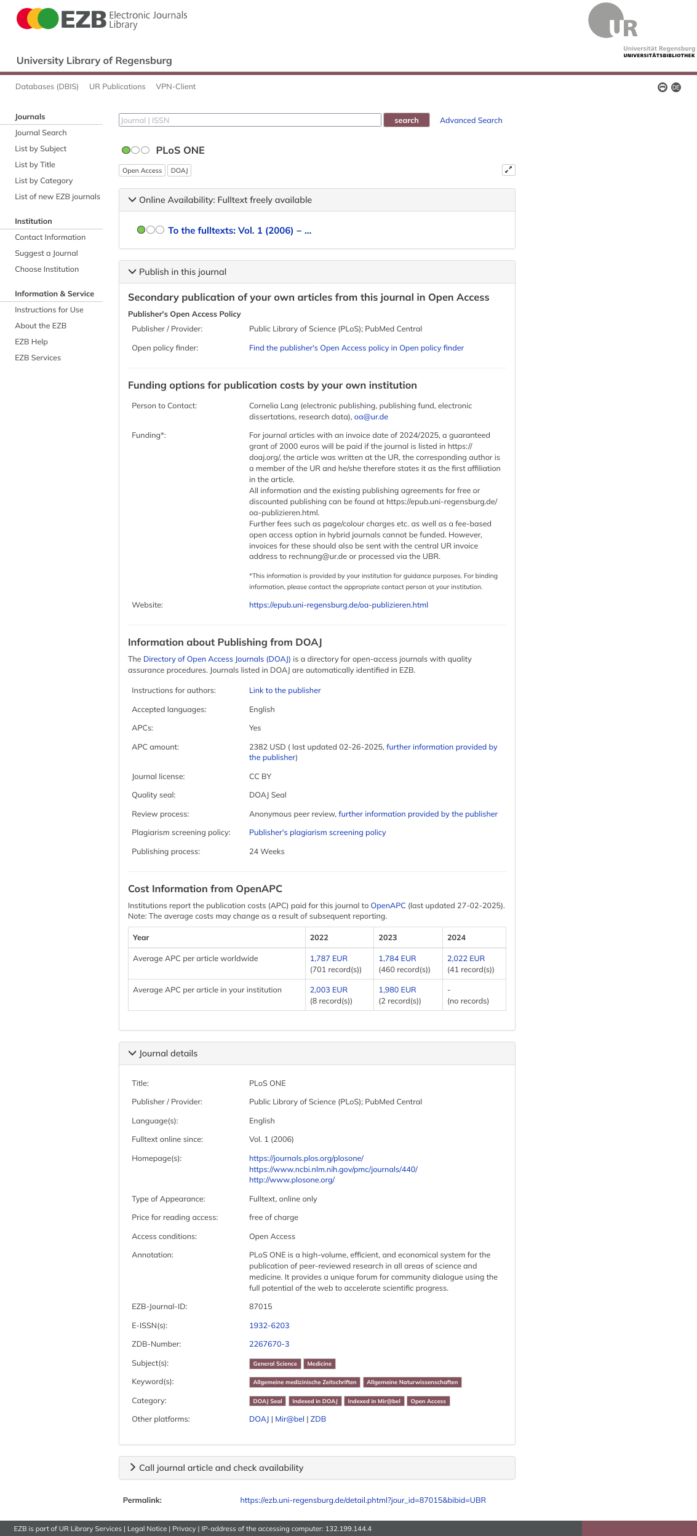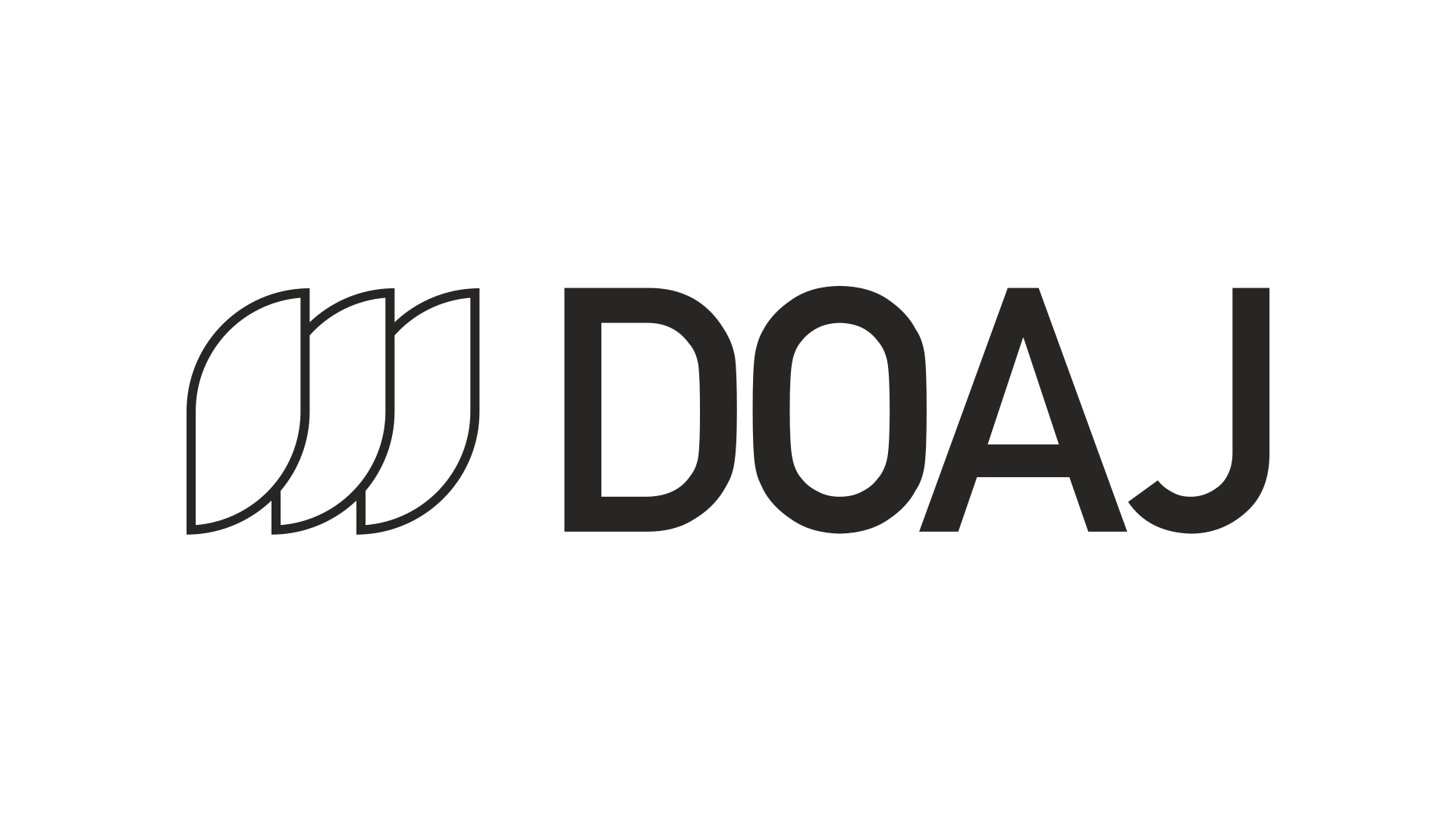This blog post describes how the exchange of open metadata between DOAJ and EZB promotes open access and improves the transparency of publication costs.
The open access publishing landscape is becoming increasingly complex. Essential information – such as journal information on publishing, publication costs, possibilities for grants in institutions, or participation in publishing agreements – is often scattered or outdated, making it difficult for authors to find their way around.
The collaboration between the DOAJ and the EZB helps to simplify things by consolidating information on publishing. Authors and researchers can easily access this information through the EZB in a unified, institution – and journal-specific way.
About the Electronic Journals Library (EZB)
The Electronic Journals Library (EZB, https://ezb.ur.de) is a service for the collaborative management of electronic journals. More than 660 libraries and research institutions participate in the EZB, jointly maintaining shared journal metadata and institution-specific licensing information, e.g., from consortia or transformative agreements. This librarian network ensures that the data remains high-quality and up to date.
With around 120,000 electronic journals, including over 83,000 freely available titles, the EZB is one of the largest bibliographic databases of scholarly electronic journals. It provides researchers with an institution-specific user interface in German and English, enabling easy and consistent access to scholarly journals. The availability of full-text access is indicated by traffic-light symbols according to the license situation in their institution.
Since 1997, the service has been hosted and managed by the University Library of Regensburg. The EZB is part of UR Library Services (URL, www.ur-library.de), which also covers the Database Information System (DBIS, https://dbis.ur.de) and the Regensburger Verbundklassifikation (RVK, https://rvk.ur.de), all united under the guiding principle of “Quality through Cooperation.” Having firmly established itself within the academic community, the EZB now offers a range of services to support academic literature and information supply.
Enhancing publication cost transparency with openCost
As part of the project openCost (www.opencost.de), the EZB has been expanded and now offers information on publishing, publication costs, and funding options for publication costs in institutions.
The openCost project, initiated by the Bielefeld University Library, the German Electron Synchrotron (DESY) in Hamburg, and the University Library of Regensburg, aims to create a technical infrastructure that allows tracking all costs associated with scholarly publishing and subsequently making them freely accessible by means of standardized interfaces. This is supposed to enable cost transparency on an institutional, national, and international level. The project is funded by the German Research Foundation (DFG), project number: 457354095.
DOAJ as important data source and collaboration partner for EZB
The DOAJ indexes high-quality, peer-reviewed open access journals. This information is crucial for students and researchers. Therefore, journals listed in the DOAJ are automatically marked accordingly in the EZB, and thanks to the EZB’s large academic network, this information is made visible and transparent to a large number of users. A remarkable reuse of this information was carried out in collaboration with the DGPhil for the listing of open access journals in the field of philosophy (see https://www.dgphil.de/die-dgphil/open-access-zeitschriften-1).
To better support researchers in the publishing process, journal-specific information from the DOAJ is imported and displayed in the EZB user interface (see Figure 1 below). This includes details such as:
- Article Processing Charge (APC)
- Links to submission guidelines
- Time to publication
- Review process information
- Publication license
- Accepted languages
Additionally, further information from the EZB and other sources is provided to support authors:
- Contact information: Direct access to the institution’s publication service and invoice processing details.
- Publication costs: Average publication costs paid for journals, retrieved from OpenAPC (https://openapc.net), an aggregator of institutional APC data.
- Possibilities for grants: Funding options for publication costs as institution-specific information maintained in the EZB.
- Journal categories: Filtering options based on EZB categories, such as Diamond Open Access, Indexed in DOAJ or Data Journal.
- Information on secondary publication: How to make already published research results freely available.
Through this collaboration, DOAJ and EZB contribute to greater transparency in scholarly publishing, empowering authors with the information they need to make informed publishing decisions.
This enables institutions to use the EZB as a central platform for distributing and communicating information on publishing. It is also possible to make use of interfaces (e.g., XML, API) in order to automate the retrieval of this information, thus enabling institutions to integrate it into their own services.
Diamond Open Access in the EZB

EZB also aims to promote Diamond Open Access (OA), a model in which authors are not charged any publication fees and readers have free access to content. These journals are typically managed by non-commercial publishers, such as academic institutions. Despite their value, many of these journals remain hidden, lacking visibility among scholars and library staff. To address this, the EZB has introduced a dedicated category for Diamond OA journals.
At present, the number of journals in the EZB that are designated as “Diamond OA journals” has surpassed 4,900, following the definition of the German Research Foundation (DFG, https://www.dfg.de/resource/blob/324442/db52a2a58f84c92b1c3d7cf9cb2eaf41/call-diamond-open-access-de-data.pdf). Furthermore, we are in dialogue with the CRAFT-OA project (https://www.craft-oa.eu/) concerning the Diamond OA criteria.
The labeling process is dependent, among other things, on the DOAJ as an established data source and active contributions from the EZB community. Regular updates ensure data is up-to-date. Currently, journals listed in the DOAJ marked as having no APCs, having no other publication costs, and being managed by other organizations are labeled in the EZB as Diamond OA journals. Libraries can further improve visibility by tagging their own Diamond OA journals.
Collaboration and data exchange for mutual benefit
The collaboration and data exchange have already led to improvements in data quality. As part of openCost, we compared Diamond OA journals in EZB with data from OpenAPC. This process resulted in a list of around 40 journals that, according to the DOAJ, do not charge publication fees, while OpenAPC contained cost data for them. For some of these titles, the information in the DOAJ has already been updated. For the remaining journals, we are in contact with the institutions that reported the cost data to OpenAPC. This joint effort highlights the importance of collaboration and continuous, timely data exchange for enhancing cost transparency in scholarly publishing.
The collaboration between the EZB and the DOAJ will continue to expand. Regular data matches and the exchange of data regarding future developments in Diamond OA are planned. This will not only help improve the quality and completeness of the data but also provide even better support for researchers and librarians.
Silke Weisheit is a business information systems specialist and academic librarian. She heads the Electronic Journals Library (EZB) at the University Library of Regensburg. She is actively contributing to the openCost project. ORCID: 0000-0002-2609-4274
Colin Sippl is in software development at the University Library of Regensburg. He has been involved in expanding the Open Access services of the Electronic Journals Library (EZB) and is actively contributing to the openCost project. ORCID: 0000-0002-8503-1740
Vicky Schirmer is a graduate engineer in multimedia technology and has long-term experience as an IT business consultant. She is a member of the Electronic Journals Library (EZB) team at the University Library in Regensburg and coordinates a cross-institutional working group that visualises data exchange processes of electronic resources between library systems. ORCID: 0000-0003-1877-0137
